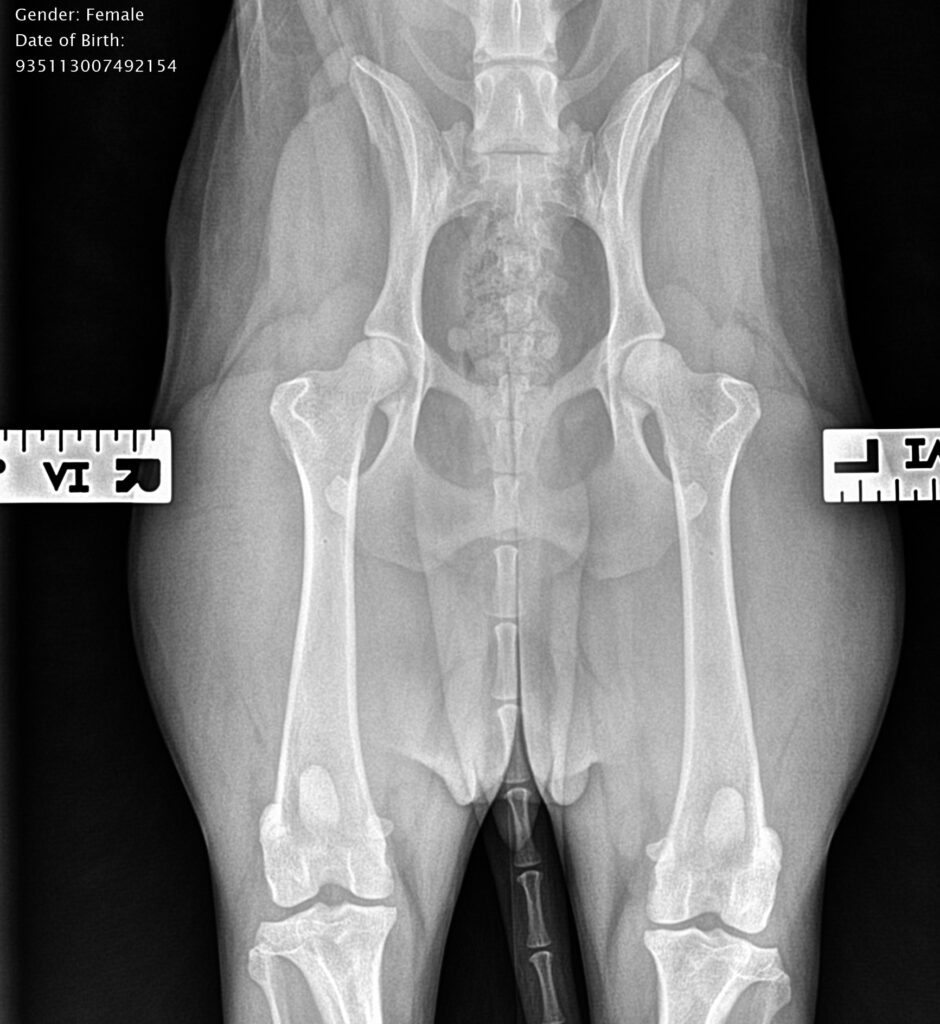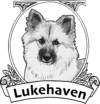OFA Health Testing
OFA Health Testing (Orthopedic Foundation for Animals) is a cornerstone of responsible Icelandic Sheepdog breeding and ownership. The OFA is a non-profit organization that maintains a database of health examinations and genetic screenings for dogs. Through OFA health testing for dogs, breeders and owners can identify any hereditary conditions early and verify a dog’s suitability for breeding, helping to reduce the incidence of genetic disorders over time. Although Icelandic Sheepdogs do not appear to be unusually predisposed to hip dysplasia, patellar luxation, or eye disorders compared to other breeds, these tests remain important to maintain the overall health and longevity of the breed. Breed-specific recommendations include:
- Hip Evaluations (OFA or PennHIP): Ensures sound hip conformation before breeding.
- Patellar Exams: Checks for kneecap alignment and potential luxation.
- Ophthalmologist Screenings (CERF/OFA Eye Certification): Confirms clear eyes free of hereditary cataracts or distichiasis.
By requiring OFA clearances before breeding, responsible breeders help preserve the breed’s overall health, extend each dog’s lifespan, and maintain the energetic temperament that defines a well-bred Icie.

1. Lifespan & General Health Profile
Icelandic Sheepdogs are generally healthy, with an average lifespan of 12–15 years. Their gene pool benefited from mid-20th-century conservation efforts, and today’s breeders collaborate globally to minimize hereditary risks. Early preventive care—supported by OFA screening—ensures most Icies live active, robust lives. The Heritage Center archives recount how early Icies withstood harsh Icelandic winters and disease outbreaks, illustrating the breed’s innate hardiness and reinforcing the need for modern health protocols.
- Average Lifespan: 12–15 years
- Overall Robustness: Thanks to a diverse gene pool maintained through controlled breeding, Icelandic Sheepdogs are generally healthy and free of widespread breed-specific diseases.
- Veterinary Partnership: Establish a relationship with a veterinarian experienced in herding or spitz breeds to monitor growth, development, and aging.
Heritage Center Note: Historical records at the Heritage Center highlight that early Icelandic Sheepdogs—with minimal human intervention—survived harsh winters and epidemics, underscoring the breed’s innate hardiness.
2. Common Hereditary Conditions Avoided with OFA Health Testing
While not markedly predisposed, responsible breeders and owners monitor for these conditions:
- Hip Dysplasia
- Malformation of the hip joint leading to arthritis or lameness.
- OFA/PennHIP Role: Radiographs evaluated by OFA ensure only dogs with acceptable hip conformation are bred.
- Patellar Luxation
- Dislocation of the kneecap causing intermittent limping.
- OFA/OFELSH Testing: Patella evaluations submitted to OFA certify alignment or grade presence.
- Eye Disorders
- Cataracts (lens opacity) and distichiasis (ingrown eyelashes).
- CERF/OFA Ophthalmologist Exams: Annual eye exams certified by OFA reduce the chance of hereditary eye conditions.
- Cryptorchidism
- Undescended testicle in males; affected dogs should be neutered and excluded from breeding.
By verifying clearances through OFA Health Testing, breeders help protect future generations from potential health issues, maintaining the Icelandic Sheepdog’s reputation for vitality, health, and longevity.
3. Recommended OFA Health Testing, Screenings & Preventive Care
- Puppy Stage (6–16 weeks): Core vaccinations (DHPP), deworming every 2–3 weeks until 16 weeks, initial veterinary checkup.
- Adolescent & Adult (6 months+):
- Orthopedic Evaluation: Hip and patella exams at 12–24 months. While OFA health testing this is done for breeding purposes, it can certainly be done for non-breeding dogs.
- Eye Exam: Annual ophthalmology check.
- Dental Assessment: Every 6–12 months; start home brushing early.
- Senior Care (8+ years):
- Biannual wellness exams including blood work to monitor organ function.
- Joint-support supplements as recommended.
Heritage Center Insight: Museum exhibits detail historic “dog plagues” (distemper outbreaks) that nearly wiped out the breed, reinforcing today’s emphasis on vigilant vaccination and disease prevention.
4. Nutrition & Weight Management
- Balanced Diet: High-quality, breed-appropriate kibble, or veterinarian nutritionist formulated diets such Farmer’s Dog – we make Farmer’s Dog recipes with their nutrients for all our dogs.
- Portion Control: Follow feeding guidelines by weight and activity level; adjust to maintain a lean, athletic build.
- Supplements: Omega-3 fatty acids for coat and joint health; probiotics for digestion.
- Avoid: Excessive treats and table scraps—Icies can gain weight, stressing joints, especially after neutering and if appropriate activity levels are not maintained.
5. Exercise & Mental Enrichment
- Daily Activity: Minimum of 60 minutes/day, mixing walks, free play, and structured sports.
- Dog Sports: Agility, rally, herding trials, and nose-work provide both physical and cognitive challenges.
- Mental Stimulation: Puzzle toys, obedience games, and trick training to prevent boredom-related behaviors.
- Low-Impact Puppy Work: Until growth plates close (12–18 months), engage puppies in short play sessions, basic obedience, and gentle balance exercises—avoiding jumping or high-impact maneuvers.
Heritage Center displays show Icies historically used simple corridor herding games to sharpen their minds—evidence that mental enrichment was as ancient as their working role.
6. Grooming & Coat Care
- Brushing: Weekly year-round; daily during seasonal “blow-outs” (spring/fall) to manage heavy shedding.
- Bathing: As needed—2–4 times per year—using a gentle, spitz-safe shampoo.
- Dewclaw & Nail Care: Trim regularly, especially double dewclaws on hind legs, to prevent overgrowth and splitting.
- Dental & Ear Hygiene:
- Brush teeth 2–3× weekly.
- Check ears weekly for debris or signs of infection; clean with veterinarian−recommended solution.
Artifacts at the Heritage Center display grooming tools used in the 19th century, reminding owners that maintaining Icies’ dense double coats has long been vital to their comfort and health.
7. Preventive Wellness Checklist
| Task | Frequency | Notes |
|---|
| Veterinary wellness exam | Annually (biannual for seniors) | Include weight, dental, and joint check |
| Vaccinations & boosters | As per vet schedule | DHPP, rabies, leptospirosis, Lyme, etc. |
| Heartworm & parasite control | Monthly | Year-round protection recommended |
| Joint-support supplements | Daily or as directed | Glucosamine, chondroitin for seniors |
| Microchip & ID verification | Once & as needed | Confirm contact info annually |
8. Genetic Conservation & Heritage
- National Conservation Plan (2024): Iceland’s Agricultural Genetic Resources Committee has formally recognized the Icelandic Sheepdog as a native genetic resource, incorporating it into a national conservation strategy.
- Heritage Center Role: The Sheepdog Heritage Center serves as a hub for breed data collection—helping coordinate surveys of living dogs in Iceland and abroad to guide future breeding and health initiatives.
- Breeder Collaboration: Active partnerships between DÍF (Iceland), ISAA (USA), and ISIC (international) ensure ongoing sharing of pedigrees and health results including OFA health testing to maintain genetic diversity.
9. OFA Health Testing Frequently Asked Questions
By prioritizing OFA Health Testing, responsible breeding, and attentive care, you ensure your Icelandic Sheepdog thrives in both health and spirit—preserving a living legacy that dates back to Viking settlers.
